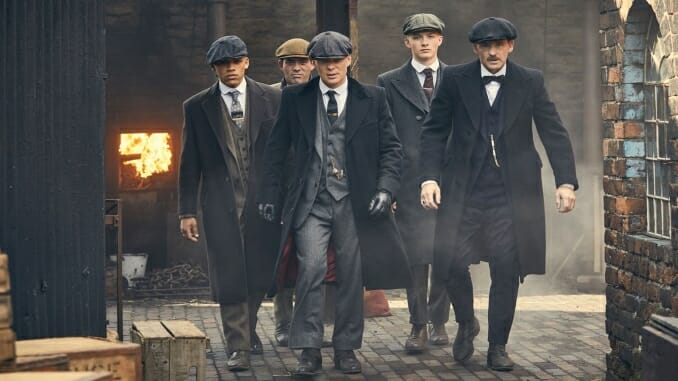How Peaky Blinders Became a Genuine Surprise Hit of the Streaming Era
Photos Courtesy of Netflix
The streaming wars have taken over television to such a degree that it’s hard to imagine the place where it started. Netflix is now an equal player alongside cable mainstays and premium juggernauts like HBO, but in 2014, the Netflix home page was a very different place. The “originals” branding was a rare sight because it was so few and far between. And it may almost be lost to history that one of the earliest shows with that logo was in fact Peaky Blinders.
The stylish gangster drama emerged from nowhere, premiering on Netflix in two parts in September and October of 2014. It came about in Netflix’s early stage of “original” programming which consisted of licensing overseas (mostly British) TV for North American audiences. The international rights for Peaky Blinders were bought from the Weinstein Company, who produced the show during much of its run.
Netflix’s buy for Peaky Blinders was risky. The show was popular enough in the UK but aired on BBC Two, a step below the more popular BBC One. The show had some actors recognizable to an American audience, but Jurassic Park star Sam Neill as Chester Campbell and recent Christopher Nolan recruit Cillian Murphy as Thomas Shelby aren’t huge stars on their own. Netflix’s all-mighty algorithm was still in its early stages as well, so the show didn’t receive the aggressive push their originals do now.
The end result was Peaky Blinders making a quiet first impression. It was recommended to people who watched other British series or historical crime dramas but received little fanfare. Any search for conversations about the show after the 2014 Netflix release produced few results beyond the odd fan page or underdeveloped wiki.
It wasn’t until after the release of Season 3 that the conversation around the show changed. Peaky Blinders is a series that’s hard to forget; its stylish production and outside-the-box creative choices make it stand out amongst contemporaries. But when Season 3 premiered on Netflix in 2016, it was a different streaming landscape, one where the amount of true originals had dramatically increased. Despite being labeled as a Netflix original, Peaky Blinders is not produced by Netflix, unlike most of its well known series such as Stranger Things and The Crown. So even with a stronger algorithm and strategy for pushing originals, Season 3 of Peaky Blinders was not a priority for Netflix.
And yet, something unexpected happened: people started watching. Those who saw the first two seasons aggressively recommended the show to friends. Peaky Blinders lends itself well to word of mouth—any show that can be described as a 1920s gangster drama set to the music of Nick Cave and the White Stripes is sure to pique someone’s interest. The release of Season 3 in 2016 brought along one of the biggest word-of-mouth campaigns seen in the Peak TV era. Peaky Blinders picked up a list of celebrity recommenders, including the likes of Brad Pitt, Snoop Dogg, and David Bowie, who bestowed glowing praise. Bowie was such a fan that he even gave the show permission to use his music shortly before his death. On the Twitter side, both Stephen King and Ron Howard tweeted recommendations for the show in 2016.
The shift between the release of Season 3 and Season 4 cannot be understated. While Netflix does not release viewership numbers, the increasing social capital of Peaky Blinders could be seen all over the internet. “Peaky fooking Blinders” jokes increased exponentially. The best evidence of the impact comes from the increase in viewership for the show in the UK. The cumulative viewing audience almost doubled between Season 3 and 4.